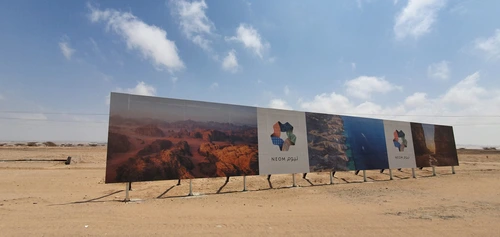
Humanity has built new cities throughout history. Some emerged organically to support trade networks, some as defensive strongholds, and others as the realised dream of a modernising monarch or a unifying political leader. In the modern, post-Second World War era, hundreds of deliberately planned new cities have been built or are currently in development. The number of new city projects has exploded in the past two decades – but why?

The world is undergoing its final wave of urbanisation
While most of the high-income world is already about as urbanised as it will likely ever be, with any future changes being marginal, low and middle-income countries are undergoing an urban explosion. India, China and Nigeria alone are expected to add 416 million, 255 million, and 189 million new urban residents, respectively, by 2050. Nearly all the most rapidly urbanising countries in the world today are located in sub-Saharan Africa, and this region will be home to the world’s leading megacities by the end of the century, surpassing Asia.
But as these countries approach 40%, 50% or 60% urbanisation, they’re doing so at significantly lower levels of income and with significantly less state capacity than, for example, the US in the 1920s or South Korea in the 1970s.
So as cities throughout sub-Saharan Africa, South Asia and elsewhere undergo extremely rapid urban growth, their economies are proving incapable of productively employing a growing, and very young, workforce and their governments are proving incapable of building sufficient infrastructure or providing sufficient public services. These are deeply challenging problems of political economy to solve. New cities are offering a valuable, albeit incomplete, solution.
Building a new city on the outskirts of Lagos or New Delhi doesn’t solve their respective problems overnight. However, it does help meet the overwhelming public demand for new urban spaces and the economic opportunity those spaces are expected to provide. New cities, which are often endowed with some form of special economic zone status, and are targeted towards specific industries, can become new hubs that are far more attractive to potential investors and entrepreneurs, with better policy regimes and infrastructure support, than existing cities.
Retrofitting existing infrastructure can be several times more expensive than building new infrastructure – getting the bones of a city “right” in advance of settlement is helping to address the economic and humanitarian challenges faced by millions of urban dwellers.
For many urbanites worldwide, physical environment limits their economic potential and quality of life
It’s hard to be a remote-working software developer in Nigeria if the internet and electricity are frequently out of service. It’s hard to raise a family in a city where there are no sidewalks or public safety is a major concern. Cities generate economic progress and new ideas by attracting lots of people to a single location, the creation of agglomeration economies.

New city projects like Itana, outside Lagos, or Silicon Zanzibar, are rebuilding these talent networks in new, more attractive, and more productive locations. New cities like Ciudad Morazán, Honduras, or Small Farm Cities Malawi are offering the average family in poor countries quality housing they can actually afford, good jobs, and safe, vibrant communities.
Industrial-scale new cities like Enyimba Economic City, Nigeria, and Gu’an New Industry City, China, are creating the physical and policy environments needed to generate real economic progress, which is not always easily replicated in existing cities.
The history of building new cities
Beyond the economic factors driving the creation of new cities, it’s undeniable that building new cities is an inherently interesting, exciting venture. In the history of new cities, this energy has manifested itself with incredible results, such as St. Petersburg, Peter the Great’s Russian gateway to the west. However, at other times, there are new cities that prove to be nothing more than white elephants that waste valuable public revenues or private capital.
It’s great that Brasilia looks like a bird or an aircraft when viewed from above, but whether Brasilia works for those relegated beyond the city’s wings is a more important question. Is Akon’s proposed city with its eponymous cryptocurrency really the right project to accelerate Senegal’s development? How many times are we going to hear about new smart cities being just around the corner in India?
For some new cities, it’s simply too early to render an honest judgment. Saudi Arabia’s Neom project has attracted throngs of admirers and detractors for its unique 170km straight-line urban plan. It could be a bust, like its predecessor King Abdullah Economic City, or it might very well introduce new dynamism to the Saudi economy and even some liberalism to Saudi society. And we shouldn’t forget China’s famous “subway to nowhere,” where just a few short years after this rail expansion was roundly mocked, it became a subway to somewhere.
Humans have always built new cities and have done so for an endless list of reasons
Today’s new city builders are no different, with visions ranging from boosting innovation to unlocking the economic potential for the poor to cementing political or cultural legacies to combatting the effects of climate change and raising sea levels. New cities are “having a moment” as builders and policymakers scramble to answer the immense challenges and opportunities posed by urbanisation at a pace and on a scale never seen before.
The New Cities Map was built by Charter Cities Institute to address these challenges and provide data-driven answers. The open-source database catalogued every contemporary new city built since 1945, recording their development structure, finances, history, and governance. By looking backwards at unprecedented quantitative data, researchers and policymakers will have a greater ability to comprehend what makes a new city succeed or fail.
With the trend of new cities appearing everywhere unlikely to subside, it’s in the global interest to understand how to get them right.
[Read more: South Africa doesn’t need new cities: It needs to focus on fixing what it’s got]






